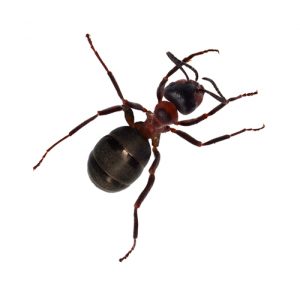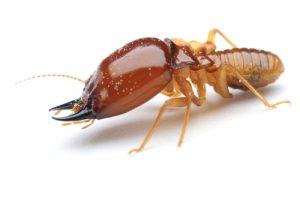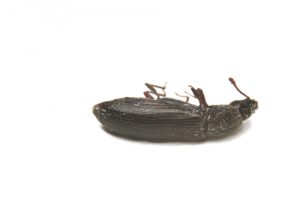What Eats Wood?
By Chris Williams on February 24, 2012.
Q. What eats wood? My carpenter brought me a piece of wood that looks like it has been eaten! He showed me what look like chambers and tunnels in the wood, and some material was falling out! There were no live bugs that he could find but he did say that it looks like there is more damage where he is going to replace a section of siding. I’m concerned that my house is being eaten by something. What could cause this type of damage?
A. Your carpenter is right to be concerned, this does sound like pest damage. Pest damage is often discovered during renovations, repairs, or routine maintenance. Due to the cryptic, or hidden nature of most wood destroying organisms, damage may go un-noticed for some time and be quite extensive. Early detection and timely treatment are key in limiting damage. Several insect pests come to mind in situations like this; Carpenter Ants, Termites, and Powder Post Beetles are at the top of the list. These three groups of insects cause the majority of pest related damage in homes. Termites and powder post beetles cause damage by consuming wood as a food source. Over long periods of time damage can be quite extensive. Moisture and proximity to the soil are factors that favor termites and powder post beetles. Carpenter ants will also nest in areas near moisture. Although they do not eat wood, their nesting activity may cause damage to wood members and is of obvious concern.
 Carpenter ants nest in hollow trees (they can hollow them out). Wall voids are just like hollow trees. Sometimes the carpenter ant galleries can damage sills, studs, and rims of homes. Flooring and decking are also great places to excavate galleries. The nest itself may be quite large. Eggs and larvae must be kept clean and relatively dry. Pupae require a warm location for pupation like an attic or South facing wall. Worker ants find water near sinks and bathrooms in spring. Carpenter ants are carnivores and prefer to feed on live prey found on trees, bushes, and shrubs outside the home. Carpenter ants do not eat wood but have the ability to create galleries or tunnels within it. The nest area is generally clean of debris like sawdust or dead insects. The chambers are very organic looking, almost artistic in structure. If the nest is active, live ants will be swarming all around collecting eggs, larvae, and pupae as the nest is disturbed. Sawdust, or frass is usually carried away from the nest but may be found inside wall voids, behind insulation, or piled up somewhere. Dead insects, ants and other material will be located in the frass pile. This material is relatively uniform, and course in texture. The more sawdust like material present, the more extensive the nest/damage may be.
Carpenter ants nest in hollow trees (they can hollow them out). Wall voids are just like hollow trees. Sometimes the carpenter ant galleries can damage sills, studs, and rims of homes. Flooring and decking are also great places to excavate galleries. The nest itself may be quite large. Eggs and larvae must be kept clean and relatively dry. Pupae require a warm location for pupation like an attic or South facing wall. Worker ants find water near sinks and bathrooms in spring. Carpenter ants are carnivores and prefer to feed on live prey found on trees, bushes, and shrubs outside the home. Carpenter ants do not eat wood but have the ability to create galleries or tunnels within it. The nest area is generally clean of debris like sawdust or dead insects. The chambers are very organic looking, almost artistic in structure. If the nest is active, live ants will be swarming all around collecting eggs, larvae, and pupae as the nest is disturbed. Sawdust, or frass is usually carried away from the nest but may be found inside wall voids, behind insulation, or piled up somewhere. Dead insects, ants and other material will be located in the frass pile. This material is relatively uniform, and course in texture. The more sawdust like material present, the more extensive the nest/damage may be.
 Termites eat wood, paper, and other cellulose containing material. Subterranean termite nests are located in the soil and consist of a mated king and queen termite, workers, nymphs, and allates. These highly social insects communicate with pheromones. Building extensive tunnel systems in search of food sources, termites are able to feed in discreet locations without discovery. Subterranean termites are by far the most damaging insect when it comes to eating wood. A mature colony(+3-5 yrs.) of the Eastern Subterranean termite requires approximately 1 cubic foot of wood, or more per year. Formosan termites, whose colonies are gigantic, can consume 20 times that amount!
Termites eat wood, paper, and other cellulose containing material. Subterranean termite nests are located in the soil and consist of a mated king and queen termite, workers, nymphs, and allates. These highly social insects communicate with pheromones. Building extensive tunnel systems in search of food sources, termites are able to feed in discreet locations without discovery. Subterranean termites are by far the most damaging insect when it comes to eating wood. A mature colony(+3-5 yrs.) of the Eastern Subterranean termite requires approximately 1 cubic foot of wood, or more per year. Formosan termites, whose colonies are gigantic, can consume 20 times that amount!
Termites scour the area around their colony for food sources. Stumps, landscaping timbers, bark mulch, wood piles, downed trees, and scrap piles are common food sources found near homes. Wood sills, rim joists, floor joists, support posts, door frames, sheet rock, window frames, partition walls, and stair risers are common places where termites have access to wood within a structure. Working discretely within the wood, damage may slowly accumulate until something breaks open, falls apart, or termite swarmers flood out of the wall one spring morning.
Termites swarm on warm spring days, dropping off their 4 identical wings everywhere and forming mating pairs. Most swarmers, or allates will die through desiccation or becoming food for insectivores. Swarming will continue until all allates have left the nest. Subterranean termites require moisture to survive. Water leaks, poor drainage, and wood soil contact allow termites the ability to live above the soil within wood members. Control of moisture and ground contact are critical when managing termite damage. Subterranean termites are closely linked to the soil. The tunnels and chambers they construct are made with soil, saliva, and wood particles. Moisture allows this mixture to hold together, forming a controlled environment for the termites to live in. Termite damage is associated with soil found within wood, sometimes tightly packed soil fills galleries as a way to hold moisture above ground. Feeding usually follows the grain of the wood and may continue a long way along the length of the wood member. As termites work farther and farther from the soil, more moisture needs to be imported. If termites are not controlled, damage will continue to accrue.
 Powder post beetles also eat wood! Adult beetles emerge form infested wood in mid to late summer and mate. Males hover after emergence and locate females with extremely sensitive antennae. Gravid females seek out wood with acceptable resources and moisture content. Eggs are laid in pores or cracks on the woods surface. Tiny larvae hatch and begin feeding on the wood. As the larvae grow they feed within the wood. PPB frass is a powder-like material made of mostly undigested wood particles. Frass may fall out of infested timbers when tapped. Emerging adult beetles make little rings, piles, or lines of fresh powder as they come out of the wood. Visible emergence holes can be noted on infested wood members. Infested wood may sufficiently deteriorate to the point of needing replacement. Most PPB species require wood with a high moisture content. Considering factors that contribute high moisture levels within a structure is critical in managing powder post beetle infestation.
Powder post beetles also eat wood! Adult beetles emerge form infested wood in mid to late summer and mate. Males hover after emergence and locate females with extremely sensitive antennae. Gravid females seek out wood with acceptable resources and moisture content. Eggs are laid in pores or cracks on the woods surface. Tiny larvae hatch and begin feeding on the wood. As the larvae grow they feed within the wood. PPB frass is a powder-like material made of mostly undigested wood particles. Frass may fall out of infested timbers when tapped. Emerging adult beetles make little rings, piles, or lines of fresh powder as they come out of the wood. Visible emergence holes can be noted on infested wood members. Infested wood may sufficiently deteriorate to the point of needing replacement. Most PPB species require wood with a high moisture content. Considering factors that contribute high moisture levels within a structure is critical in managing powder post beetle infestation.
Based on the information provided, it is difficult to say which pest is actually responsible for the damage you described. Suffice to say that it is likely pest related. Here is the good news: your problem is not only common, but easily resolved. A Pest Control Professional will quickly identify the pest in question and offer a safe and effective solution to the problem. Don’t wait for damage to continue, call as soon as you suspect insect or other pest activity!